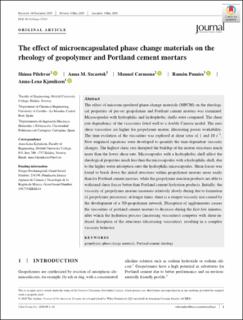| dc.contributor.author | Pilehvar, Shima | |
| dc.contributor.author | Szczotok-Piechaczek, Anna Maria | |
| dc.contributor.author | Carmona, Manuel | |
| dc.contributor.author | Pamies, Ramon Francisco Porras | |
| dc.contributor.author | Kjøniksen, Anna-Lena | |
| dc.date.accessioned | 2020-06-10T16:00:21Z | |
| dc.date.available | 2020-06-10T16:00:21Z | |
| dc.date.created | 2020-06-10T10:28:04Z | |
| dc.date.issued | 2020-05-13 | |
| dc.identifier.citation | Journal of The American Ceramic Society. 2020, 00 1-18. | |
| dc.identifier.issn | 0002-7820 | |
| dc.identifier.uri | https://hdl.handle.net/11250/2657610 | |
| dc.description.abstract | The effect of microencapsulated phase‐change materials (MPCM) on the rheological properties of pre‐set geopolymer and Portland cement mortars was examined. Microcapsules with hydrophilic and hydrophobic shells were compared. The shear rate dependency of the viscosities fitted well to a double Carreau model. The zero shear viscosities are higher for geopolymer mortar, illustrating poorer workability. The time evolution of the viscosities was explored at shear rates of 1 and 10 s−1. New empirical equations were developed to quantify the time‐dependent viscosity changes. The highest shear rate disrupted the buildup of the mortar structures much more than the lower shear rate. Microcapsules with a hydrophobic shell affect the rheological properties much less than the microcapsules with a hydrophilic shell, due to the higher water adsorption onto the hydrophilic microcapsules. Shear forces was found to break down the initial structures within geopolymer mortars more easily than for Portland cement mortars, while the geopolymer reaction products are able to withstand shear forces better than Portland cement hydration products. Initially, the viscosity of geopolymer mortars increases relatively slowly during due to formation of geopolymer precursors; at longer times, there is a steeper viscosity rise caused by the development of a 3D‐geopolymer network. Disruption of agglomerates causes the viscosities of portland cement mortars to decrease during the first few minutes, after which the hydration process (increasing viscosities) competes with shear‐induced disruption of the structures (decreasing viscosities), resulting in a complex viscosity behavior. | |
| dc.language.iso | eng | |
| dc.publisher | Wiley; American Ceramic Society (ACERS) | |
| dc.rights | Navngivelse 4.0 Internasjonal | |
| dc.rights.uri | http://creativecommons.org/licenses/by/4.0/deed.no | |
| dc.subject | geopolymer | |
| dc.subject | phase change materials | |
| dc.subject | Portland cement | |
| dc.subject | rheology | |
| dc.title | The effect of microencapsulated phase change materials on the rheology of geopolymer and Portland cement mortars | |
| dc.type | Peer reviewed | |
| dc.type | Journal article | |
| dc.description.version | publishedVersion | |
| dc.source.pagenumber | 1-18 | |
| dc.source.volume | 00 | |
| dc.source.journal | Journal of The American Ceramic Society | |
| dc.identifier.doi | 10.1111/jace.17215 | |
| dc.identifier.cristin | 1814720 | |
| dc.relation.project | Norges forskningsråd: 238198 | |
| cristin.ispublished | true | |
| cristin.fulltext | original | |
| cristin.qualitycode | 2 | |

